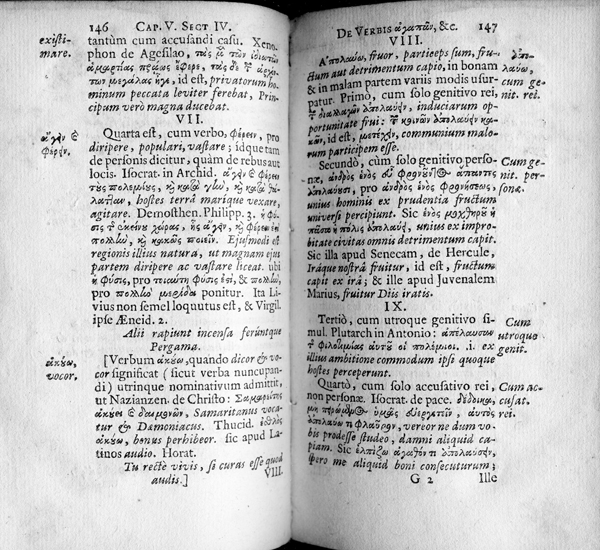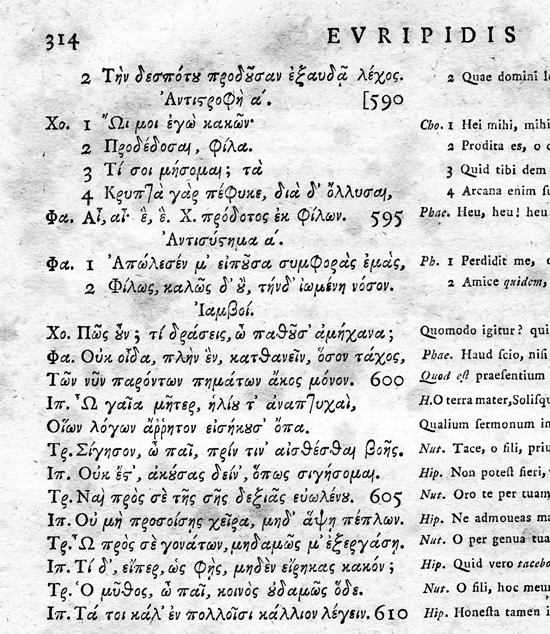

Although there were a few experiments with printing Greek texts in capital script only, most early printers simply reproduced in type the writing style of contemporary scribes, including the use of variant letter forms (both majuscule and minuscule), ligatures, and abbreviations. This rendered Greek typography far more complicated than it needed to be, and eventually fonts were developed that simply used the 24 letters of the Greek alphabet in lowercase (minuscule) and uppercase (majuscule) forms, with uppercase limited mainly to proper names and decorative initials.
The following image, from the handbook of Greek idioms published by François Viger in 1647 and frequently reprinted for two centuries (this image is from a 1680 printing), shows many ligatures and abbreviations: on p. 146 in the second line is a suspended abbreviation for the εν in μὲν, and in the third line τῶν is a tau with the combined abbreviation for ων and circumflex accent above it; in paragraph VII, the marginal rubric conrtains one form of the abbreviation for καὶ and the fifth line of the paragraph shows a different one.

Here is a transcription of the Greek on p. 146:
lines 2-4: τὰς μ(ὲν) τῶν | ἁμαρτίας πρᾴως ἔφερε, τὰς δὲ τ(ῶν) ἀρχόν|των μεγάλας ἧγε
in margin at VII: ἄγειν κ(αὶ) φέρειν
lines 11-13: ἄγειν κ(αὶ) φέρειν | τοὺς πολεμίους, κ(αὶ) κατὰ γῆν κ(αὶ) κατὰ θά|λατταν
lines 15-17: ἡ φύ|σις τ(ῆς) ἐκείνου χώρας, ἧς ἄγειν, κ(αὶ) φέρειν ἐστὶ \ πολλὴν, κ(αὶ) κακῶς ποιεῖν
lines 20-21: ἡ φύσις, pro τοιαύτη φύσις ἐστὶ, et πολλὴν, pro πολλὴν μερίδα ponitur
line 26 (and in margin): ἀκούω
lines 29-30: Σαμαρείτης ἀκούει κ(αὶ) δαιμονῶν
lines 31-32: ἐσθλὸς ἀκούω
Next is a partial image of a page for Euripides' Hippolytus from the reprint of J. Barnes' edition produced by C. D. Beck in 1778. The font is now simplified to a great extent, but there are still ligatures for ου, στ, αι, and an alternative (enlarged, cursive) form of tau is used when it follows pi, but not elsewhere.

Here is a transcription of the first sixteen lines:
τὴν δεσπότου προδοῦσαν ἐξαυδᾷ λέχος. (590)
ἀντιστροφὴ αʹ.
Χο. ᾤμοι ἐγὼ κακῶν·
προδέδοσαι, φίλα.
τί σοι μήσομαι; τὰ
κρυπτὰ γὰρ πέφυκε, διὰ δ’ ὄλλυσαι,
Φα. αἶ, αἶ· ἓ, ἓ. Χ. πρόδοτος ἐκ φίλων. (595)
ἀντισύστημα αʹ.
Φα. ἀπώλεσέν μ’ εἰποῦσα συμφορὰς ἐμὰς,
φίλως, καλῶς δ’ οὒ, τήνδ’ ἰωμένη νόσον.
ἰαμβοί.
Χο. πῶς οὖν; τί δράσεις, ὦ παθοῦσ’ ἀμήχανα;
Φα. οὐκ οἶδα. πλὴν ἓν, κατθανεῖν, ὅσον τάχος,
τῶν νῦν παρόντων πημάτων ἄκος μόνον. (600)
Ιπ. ὦ γαῖα μῆτερ ἡλίου τ’ ἀναπτυχαὶ,
οἵων λόγων ἄῤῥητον εἰσήκουσ’ ὄπα.
Credits: Text by Donald Mastronarde, January-February 2009. Images of Tebtunis Papyri by permission of the Center for the Tebtunis Papyri and The Bancroft Library. Images of the medieval manuscript (MS UCB 143 v. 107) by permission of The Bancroft Library: for more on this manuscript see Mastronarde, "A Manuscript of Anastasius Sinaita in Berkeley," Scriptorium 43 (1989) 130-140. Image of wooden tablet provided by and by permission of the Phoebe Apperson Hearst Museum of Anthropology: for more information about this tablet, see Raffaella Cribiore, "A Schooltablet from the Hearst Museum," Zeitschrift für Papyrologie und Epigraphik 107 (1995) 263-270. Images of casts of inscriptions courtesy of Stephen G. Miller. Other images created by Donald Mastronarde. Vase image scanned from Corpus Vasorum Antiquorum, USA 5, U. of Cal. 1 (thanks to Professor Crawford Greenewalt, jr., for pointing the way to this example). Printed book scans from personal copies of De praecipuis Graecae dictionis idiotismis, auctore Francisco Vigero [1590-1647], Leiden 1680 (first ed. 1647), and Euripidis Tragoediae Fragmenta Epistolae ex editione Iosuae Barnesii nunc recusa… (ed. C. D. Beck) Leipzig, vol.1, 1778. Nikolaos Papazarkadas identified the inscriptions on the casts.